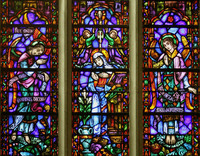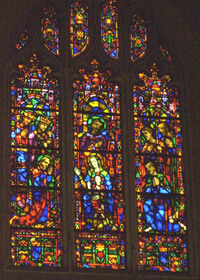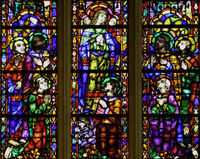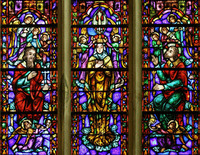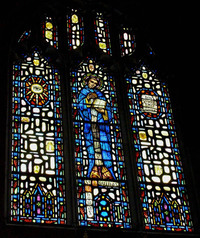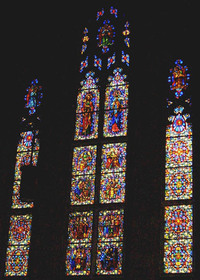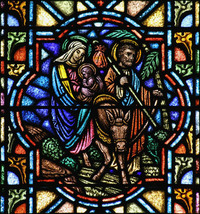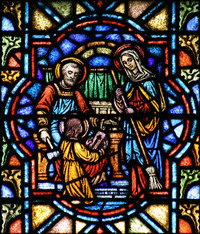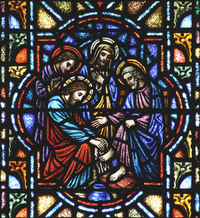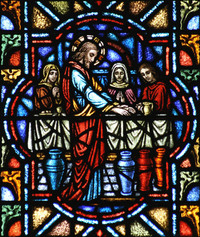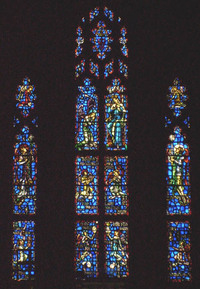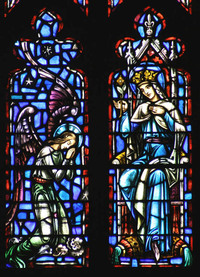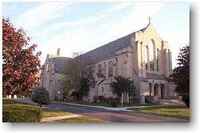MSGC : Featured Windows : Current Window
Featured Windows, November 2010
Assumption of the Blessed Virgin Mary Catholic Church (Assumption Grotto Church)
Building: Assumption Grotto Catholic Church
City: Detroit
State: Michigan
Assumption of the Blessed Virgin Mary Catholic Church, Detroit, MI. Constructed 1928-1929. Aloys Frank Herman, Inc., architect.
Assumption of the Blessed Virgin Mary Catholic Church, known also as Assumption Grotto Church, was founded in 1832, when newly arrived Catholic immigrants from Germany built a log church on the site of the present church in what was then the outskirts of Detroit. The pioneers had settled in a rural area outside the city to avoid a cholera epidemic and they called their small church “Kirche im Walde”, or Little Church in the Woods. In 1847 the church, known by its present name, was designated a parish, the second oldest parish in Detroit. The first log church was replaced by two successive brick structures, one built in 1852 and another in 1908. The fourth and present limestone-faced church, constructed in 1928-1929, was designed by the Detroit architectural firm of Aloys Frank Herman, Inc., in a Neo-Gothic basilica-type plan to accommodate 1100 people. The church is part of a complex on the parish grounds that also includes a parish house, rectory, cemetery and grotto or shrine within the cemetery. The limestone Grotto of Our Lady of Lourdes, dedicated in 1881 and rededicated in 2002, was designed by Detroit architect Peter Dederichs, Jr. to replicate the Shrine of Our Lady of Lourdes in France. Like its French counterpart, the Grotto attracts many visitors each year and has given Assumption Grotto Church its more familiar name. The entire complex has been designated as a Michigan Historic Site and registered in the National Register of Historic Places.
The stained glass windows of Assumption Grotto Church came from the Willet Stained Glass & Decorating Company of Philadelphia, then headed by Anne Lee Willet, widow of William Willet, and their son Henry Lee Willet. The windows were commissioned by the church architect, Aloys Frank Herman, who admired the medieval style and transparent antique glass that was favored by Willet over the opalescent glass and style made popular by Tiffany. A letter from the Willet studio in 1929 assured the pastor that the windows “will be from the finest hand blown antique glass, strongly barred and leaded with Prior’s early English slabs to be used where needed. The colors are in the glass itself and treated with oxides, gold and silver stains and acid etched after the manner of Albrecht Durer and others of the ancient glass artists whose work has stood the test of centuries. All stained portions are to be sufficiently fired in a Kiln a sufficient number of times to render them absolutely fadeless . . ” (July 16, 1929).
Documents in the parish archives suggest that Mrs. Willet was responsible for the window designs. An accomplished artist in her own right, she had worked with her husband since the founding of their studio in 1898 until his death in 1921. The studio also continued to use some of William’s designs for its commissions. At architect Herman’s invitation, Mrs. Willet visited the church in 1929 to discuss the type and number of windows needed. Correspondence between Herman and the studio indicate that the nave windows were installed between 1930 and 1935. The entire project comprised 34 stained glass windows, completed and installed as funds became available. These include four windows in the apse and sanctuary, ten upper nave windows, two transept windows and a west façade window, as well as smaller windows in the sacristry, ambulatory, baptistry, narthex and confessional. There is also a small rose window in the Grotto, made in 1960 to replace an original rose window of 1881.
The four large windows in the apse and sanctuary at the east end of the church depict the “Life of the Virgin” with scenes of the Annunciation, the Nativity, the Assumption and the Coronation of Mary, as described in Biblical texts and sacred traditions.
Left: The Nativity. Assumption Grotto Church, Detroit, MI. This apse window presents the familiar nativity scene, with Mary, Joseph and the infant Jesus visited by shepherds on the right and Magi or wise men from the East on the left.
Right: Detail, The Annunciation. Assumption Grotto Church, Detroit, MI. In this window detail, the angel Gabriel informs Mary that she is to become the mother of Jesus.
Left: Detail. The Assumption. Assumption Grotto Church, Detroit, MI. According to sacred tradition, Mary ascended bodily to heaven at the end of her life. This apse window detail illustrates the traditional account that gives the church its name.
Right: Detail. The Coronation of Mary. Assumption Grotto Church, Detroit, MI. Sacred tradition also relates the coronation of Mary as the Queen of Heaven. Here, angels crown Mary who is seated between God on the left and Jesus on the right.
Ten large windows that line the north and south upper walls of the nave depict early leaders of the Christian church, including St. Ignatius of Antioch, St. Bernard of Clairvaux, St. Edward the Confessor, St. Thomas Aquinas, St. Alphonsus Liguori, St. Augustine of Hippo, St. Charles Borromeo, St. Gregory the Great, St. Stephen, and St. John Chrysostom.
Left: St. Thomas Aquinas. Assumption Grotto Church, Detroit, MI. St. Thomas Aquinas (1225-1274) was a Dominican priest who is well known for his theological writings, which he holds in his hand in this north nave window scene. The Eye of God in the left lancet represents God’s wisdom; the Latin text on the right is translated, “You have written well of me, Thomas.”
Right: Detail. St. John Chrysostom. Assumption Grotto Church, Detroit, MI. St. John Chrysostom (c. 347-407), a leader of the Eastern Church, was the archbishop of Constantinople who was praised for his eloquent preaching. His Greek surname chrysostomos means “golden mouthed.” In this detail of a window on the south nave wall, he holds a beehive from which flows the “honey” of his words.
The Holy Family Window in the south transept includes large figures of Joseph and Mary above eight smaller scenes that illustrate events in the life of the Holy Family, as described in biblical texts.
Holy Family Window. South transept. Assumption Grotto Church, Detroit, MI.
Left: Detail. The Flight to Egypt. This detail of the Holy Family window depicts the family’s flight to Egypt after an angel warned Joseph in a dream that King Herod planned to kill all children in Bethlehem two years old and under, in order to remove any threat to his throne posed by the birth of Jesus.
Right: Detail. Holy Family in Nazareth. After Herod’s death, Joseph was told in another dream to return with his family to Israel, where they settled in the town of Nazareth. This detail of the Holy Family window shows Joseph, Mary and the boy Jesus in their Nazareth home.
The north transept window presents Jesus as King and High Priest, St. Peter as first among the apostles, and eight scenes of the life of Jesus, based upon biblical accounts.
Left: Detail. Last Supper. In this detail of the north transept window, Jesus is shown washing the feet of his apostles at their Last Supper together, as an act of service and humility that they were told to emulate.
Right: Detail. Wedding Feast of Cana. This scene in the north transept window illustrates the story of Jesus turning jars of water into jars of wine, at the request of his mother who informed him of a wine shortage.
The west façade window features twelve scenes that depict angelic figures paying homage to Mary as the “Queen of Angels.”
Left: Mary Queen of Angels. West façade window. Assumption Grotto Church, Detroit, MI.
Right: Detail. Gabriel in Homage. The angel Gabriel kneels before the crowned figure of Mary in this detail of the west façade window.
Assumption of the Blessed Virgin Mary Catholic Church was registered in the Michigan Stained Glass Census by Linda Rose Davis, OCDS, Assumption Grotto Parish Archivist.
Bibliography:
Show BibliographyAshlee, Laura Rose, ed. Traveling Through Time: A Guide to Michigan's Historical Markers, Rev. ed. Ann Arbor: The University of Michigan Press, 2005, p. 454.
Assumption Grotto Catholic Church. http://www.assumptiongrotto.com/
Correspondence between Aloys Frank Herman and Anne Lee Willet, dated May 10, 1929 to Nov. 2, 1933.
Ferguson, George. Signs and Symbols in Christian Art. New York: Oxford University Press, 1961.
The Holy Bible, King James Version. New York: American Bible Society, 1999.
Jones, Robert O. Biographical Index of Historic American Stained Glass Workers. Kansas City, MO: Stained Glass Association of America, 2002.
Rose, Linda. “A Condensed History.” Assumption of the Blessed Virgin Mary (Grotto) Parish, Detroit, MI.
Weis, Helene. Archivist, Willet Stained Glass Studio. Letter to the author, Sept. 15, 1997.
Willet Hauser Architectural Glass. http://www.willethauser.com/aboutwh/ourstory/willet.asp
(MSGC 1996.0128)
Text by Betty MacDowell, Michigan Stained Glass Census, November , 2010.

